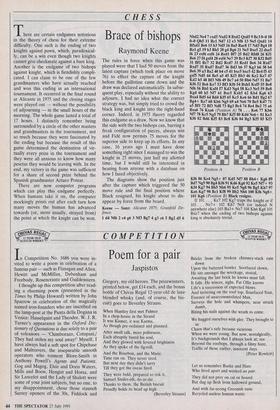CHESS
Brace of bishops
Raymond Keene
There are certain endgames notorious in the theory of chess for their extreme difficulty. One such is the ending of two knights against pawn, which, paradoxical- ly, can be a win even though two knights cannot give checkmate against a bare. king. Another is the endgame of two bishops against knight, which is fiendishly compli- cated. I can claim to be one of the few grandmasters who have actually reached and won this ending in an international tournament. It occurred in the final round at Alicante in 1975 and the closing stages were played out -- without the possibility of adjourning — in the small hours of the morning. The whole game lasted a total of 17 hours. I distinctly remember being surrounded by a circle of the other masters and grandmasters in the tournament, not so much because they were fascinated by the ending but because the result of this game determined the destination of vir- tually every prize in the tournament and they were all anxious to know how many pesetas they would be leaving with. In the end, my victory in the game was sufficient for a share of second prize behind the Spanish grandmaster Arturo Pomar.
There are now computer programs which can play this endgame perfectly. When humans take it on, the computer mockingly prints out after each turn how many moves the human has advanced towards (or, more usually, strayed from) the point at which the knight can be won. The rules in force when this game was played were that I had 50 moves from the latest capture (which took place on move 76) to effect the capture of the knight before the guillotine came down and the draw was declared automatically. In subse- quent play, especially without the ability to adjourn, I had no idea what the correct strategy was, but simply tried to crowd the black king and knight into the right-hand corner. Indeed, in 1975 theory regarded this endgame as a draw. Now we know that the side with the two bishops can, barring a freak configuration of pieces, always win and Fide now permits 75 moves for the superior side to keep up its efforts. In any case, 16 years ago I must have done something right since I managed to win the knight in 25 moves, just half my allotted time, but I would still be interested in hearing from anyone with a database on how I fared objectively.
The diagrams show the position just after the capture which triggered the 50 move rule and the final position where Black resigned, his knight about to dis- appear by force from the board.
Keene — Sanz: Alicante 1975; Grunfeld De- fence.
1 d4 Nf6 2 c4 g6 3 Nf3 Bg7 4 g3 c6 5 Bg2 d5 6
Nbd2 Ne4 7 cxd5 Nxd2 8 Bxd2 QxdS 9 Bc3 0-0 10 0-0 Qh5 11 Rcl Nd7 12 e3 Nf6 13 Ne5 Qxdl 14 Rfxdl Be6 15 b3 Nd5 16 Ba5 RacS 17 Nd3 Bg4 18 Rel g5 19 h3 Bh5 20 g4 Bg6 21 Ne5 BxeS 22 dxe5 f6 23 exf6 exf6 24 Redl Bf7 25 Bd2 RfdS 26 Kfl Be6 27 f4 gxf4 28 exf4 Ne7 29 Bc3 Kf7 30 Kf2 Bd5 31 Bfl Rc7 32 Rd2 Rcd7 33 Red! Be6 34 Rxd7 Rxd7 35 Rxd7 Bxd7 36 Bd3 h6 37 Kg3 b6 38 b4 Be6 39 a3 Ba2 40 h4 c5 41 bxc5 bxc5 42 Be4 f5 43 gxf5 Nd5 44 Be5 a5 45 Kf3 Bb3 46 Keg Ke7 47 Kd2 h5 48 Bf3 Nf6 49 Bc7 a4 50 Bb6 Nd7 51 Ba7 Kf6 52 Bc6 Ke7 53 Bf3 Kf6 54 BxhS Kxf5 55 Be8
Nf6 56 Bb5 Kxf4 57 Kd3 Ng4 58 Kc3 Ne5 59 Be8 Kg4 60 h5 Nf7 61 Bxc5 KxhS 62 Kb4 Kg6 63 Bxa4 Bd5 64 Bd4 Kf5 65 Kc5 Ke6 66 Bd1 Bg2 67 Bg4+ Ke7 68 Kb6 Ng5 69 a4 Ne6 70 Be5 Kd7 71 a5 Bfl 72 Bf3 Nd8 73 Bg3 Bc4 74 Be4 Be2 75 a6 Bxa6 76 Kxa6 (Position A) 76 . . . Ke6 77 Kb6
Nf7 78 Kc5 Ng5 79 Bbl Kf5 80 Kd4 Ne6+ 81 Ke3 Kf6 82 Bd6 Kf5 83 Bc8 Kf6 84 Bg3 Kf5 85 Kf3 Position A Position B
Kf6 86 Ke4 NgS+ 87 Kd5 Nfl 88 Bh4+ Kg6 89 Bd7 Ng5 90 Bg4 Kf6 91 Kd6 Kg6 92 Ke5 Nf7+ 93 Kf4 Kg7 94 Bh5 Nh6 95 Ke5 Ng$ 96 Bg5 Kh7 97 Ke6 Kg7 98 Bel Kfli 99 Bb2 Nh6 100 Kf6 Ng8+, 101 Kg6 (Position B) Black resigns.
If 101 . . . Ke7 102 Kg7 traps the knight or if 101 . . Ne7+ 102 Kh7 Nc8 (or indeed N anywhere else) 103 Ba3+ Ne7 104 Kh6 Kg8 105 Bxe7 when the ending of two bishops against king is absolutely trivial.


















































 Previous page
Previous page